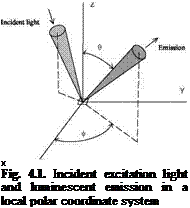Radiative Energy Transport and Intensity-Based Methods
4.1. Radiometric Notation
Luminescent radiation from a luminescent paint (PSP or TSP) on a surface involves two major transport processes of radiative energy. The first process is absorption of an excitation light through a paint layer and the second process is luminescent radiation that is an absorbing-emitting process in the paint layer. These processes can be described by the transport equations of radiative energy (Modest 1993; Pomraning 1973). The luminescent intensity emitted from a paint layer in plane geometry can be analytically determined by solving the transport equations. Thus, the corresponding photodetector output can be derived for an analysis of measurement system performance and uncertainty. Before doing a detailed analysis, it is necessary to discuss the radiometric notation. In the literature of PSP and TSP, the term ‘luminescent intensity’ or ‘fluorescent intensity’, which is usually denoted by the capital English letter ‘I’, has been widely used. In a strict radiometric sense, the luminescent intensity I is the luminescent radiance defined as the radiant energy flux (power) per unit solid angle and per unit projected area of an elemental surface of PSP or TSP (units:
,, -2 -1 -1 -2 – K
 |
watt-m – sr or J-s – m – sr ).
The radiance is a function of both position and direction, which is graphically represented by a cone of a solid angle element in radiometry as shown in Fig. 4.1. The direction of the radiance (incident or emitting radiance) is given by the polar angle в (measured from the surface normal) and the azimuthal angle ф (measured between an arbitrary axis on the surface and the elemental solid angle on the surface) in a local coordinate system. In radiometry, the radiance is conventionally denoted by the captical English letter ‘L’. The term ‘intensity’ is sometimes confusing because its definition is different in a number of different disciplines. In radiometry, the radiant intensity (units: watt-sr-1), denoted by the letter T, is the radiant flux per unit solid angle, which is different from the radiance (McCluney 1994; Wolfe 1998). However, in the literature of radiative heat transfer, the radiative intensity, denoted by the same letter 7’, is essentially equivalent to the radiance in radiometry (Modest 1993). In order to avoid confusion in notation, we specifically define the luminescent intensity T as the luminescent radiance from PSP or TSP, which is consistent with the notation and terminology commonly used in the literature of PSP and TSP. In a general case, we still use the traditional radiometric notation ‘L to denote the radiance in other
radiometric measurements and modeling. The spectral radiance such as Ix and L} at a wavelength Я (units: watt-m-2-sr-1-nm-1) is usually denoted by a subscript
Я ; the radiance I (or L) is the integration of the spectral radiance Ix (or Lx ) over
a certain range of the radiation wavelengths. Since the radiation from a luminescent molecule is isotropic, a plausible assumption is that the luminescent radiance from PSP or TSP is independent of the azimuthal angle ф. Under this
assumption, an analysis of transport of the luminescent radiative energy in PSP or TSP is considerably simplified. The following analysis is given for PSP, but it is also valid for TSP that is treated as a special case of PSP when the oxygen quenching vanishes.











